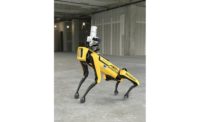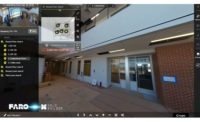Tracking work put-in-place on a job, inspectors often walk sites at the end of the week to tabulate what was installed. Processing these reports takes time, leaving many subcontractors waiting months to get paid.
“It’s a long, tedious process that can often take up to 90 days,” says Eric Law, the senior director of technology and innovation at Swinerton who is leading a pilot project to automate this process. “We were wondering, what if we can use photogrammetry or LiDAR to quantify work and submit that to the owner? That’s our thesis.”
The pilot seeks to realize the potential of 5D scheduling, where a 3D model integrates into the construction schedule and costs. The pilot project is a 197,000-sq-ft medical office building in Redwood City, Calif., chosen because it is similar to other jobs Swinerton regularly tackles. The tracking starts off with a quadruped Spot robot from Boston Dynamics walking the site with a SLAM-based sensor package from imaging firm Kaarta. The resulting 3D point clouds are then uploaded to the Avvir AI-based platform, which matches reality capture data to the project’s BIM to track changes and progress. An algorithm determines how much work has been put-in-place, allowing for payments to subcontractors to be processed faster.
The Spot robot is useful for gathering capture data during off-hours but is not crucial to the project, says Law. The data-capture device from Kaarta can also be held up by a person walking a site. “We can approximate the level of accuracy and fidelity of a terrestrial laser scanner, but with the efficiency of motion,” says Kathy Pattison, chief marketing officer at Kaarta. “In the case of the Swinerton project, it’s a four-story building. With open framing, we could scan a floor in 20 minutes.” More complex spaces with drywall and MEP installed can take up to an hour per floor to scan properly.
The scans can be performed daily, and the turnaround for Kaarta and Avvir to process the data is a few days. According to Law, the goal is to get the payment delay for subcontractors down to less than a week from 90 days.
“Using all these tools together, we think we can get more accurate data captures of work put-in-place,” says Law. “Avvir tells us what’s installed and what’s out of tolerance, and we can use that to get progress payments aligned to our BIM model elements and to our schedule.”
“When we first reached out to Swinerton in 2018, we were only working on the quality checking piece of the equation, comparing scans to BIM and identifying the geometry to find errors in construction,” recalls Raffi Holzer, CEO and co-founder of Avvir. “Swinerton challenged us to track the progress and quantify the earned value of work put-in-place. That was the original vision I had [for Avvir], but I was worried no one was interested.”
The pilot has been going on for several months, and shows promise. As of now, the Swinerton reality-capture workflow can track 50% to 60% of work performed on the site, and Law says he wants to get it to 90% before the method is production-ready. Law says the medical center’s owner is a good fit for this unusual approach to billing since they have rigorous cash flow requirements and want to avoid any unexpected invoices.
The first three months of the pilot were paid for by Swinerton, but Law says the project owner is interested in covering some of the cost going forward. “It’ll be one to two years before I can package this as a solution, but we could save a whole percentage point of the project’s cost by then,” says Law. “Piloting these solutions is not cheap, but it pays off.”
According to Law and Holzer, the business model for this 5D approach has not yet been settled upon, and will likely require new kinds of contracts to accommodate this type of work inspection. But both are excited about seeing 5D construction tools finally take hold in project workflows. “Clients have asked for 4D and 5D tools for presentation capabilities, but there wasn’t a business case,” says Law. “Now we have a business case to justify it, and it can have a real impact.”






